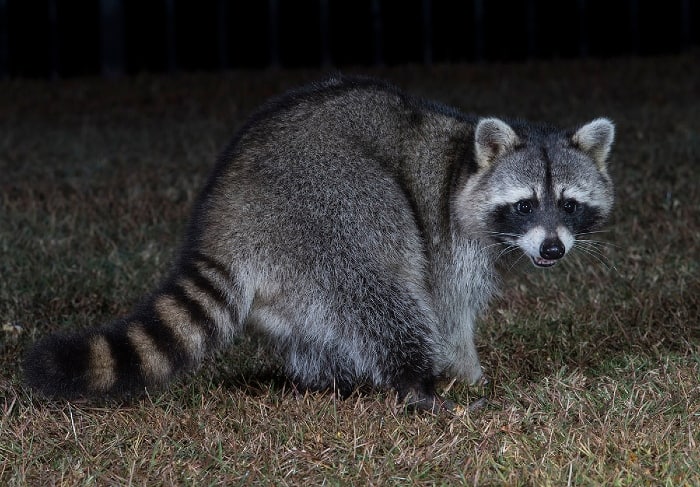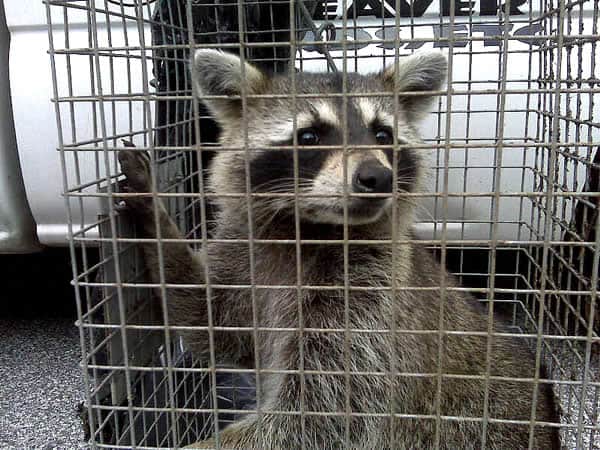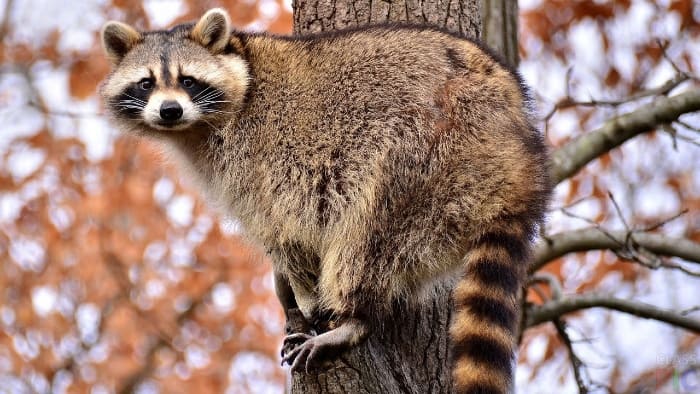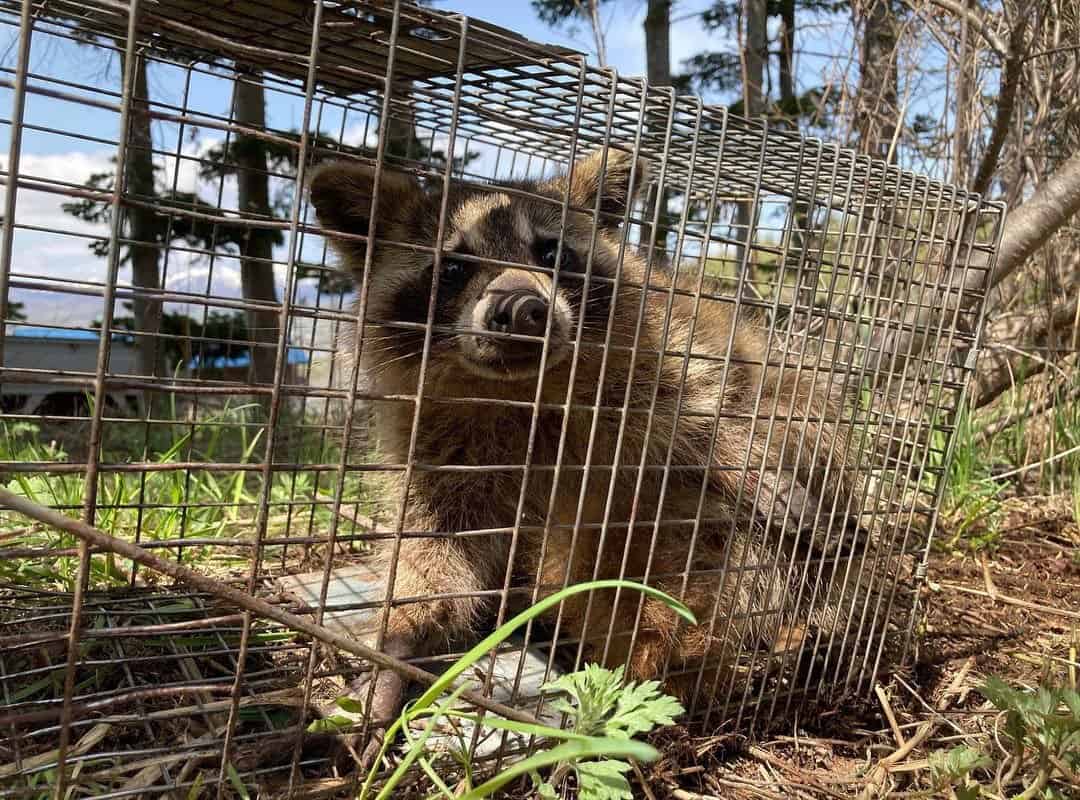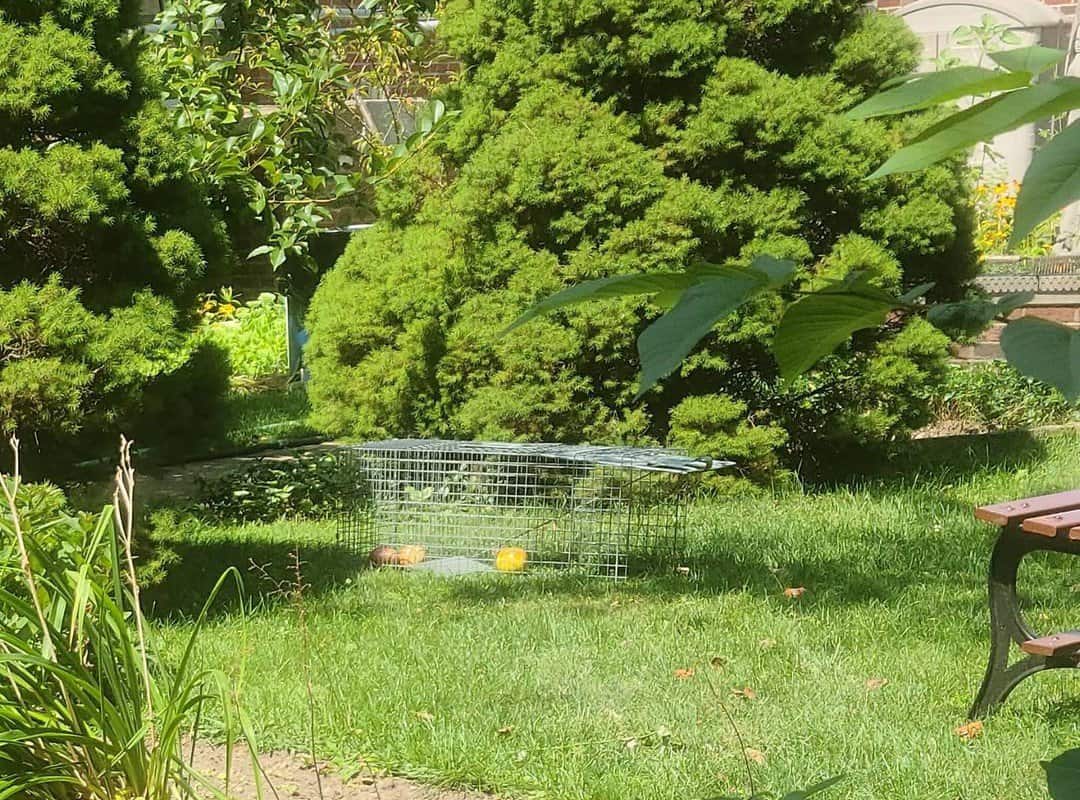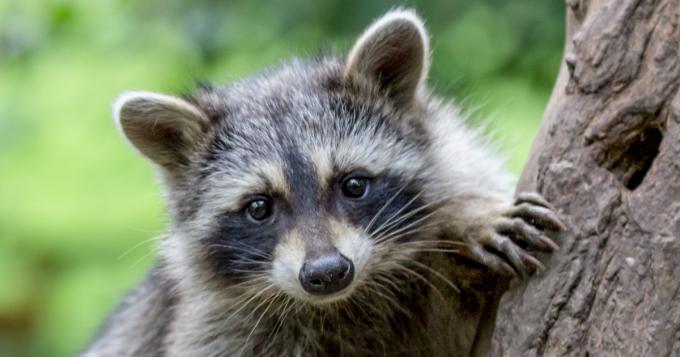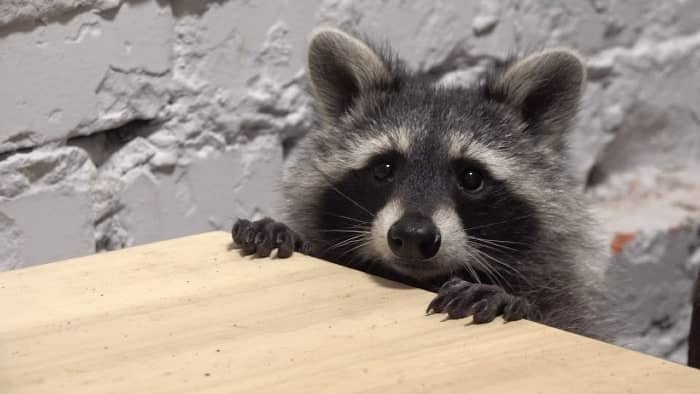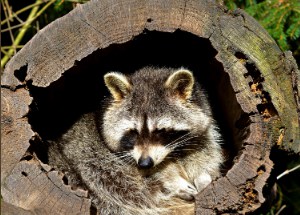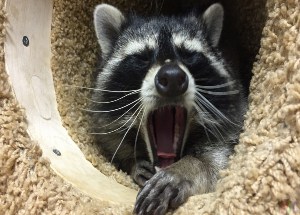This ever-smiling face may fool you into considering it friendly. Okay, a well-trained pet raccoon (if you get one) may become a real friend. But a wild raccoon is not such a good fellow; in fact, it has everything it takes to spoil your life.
How to Know a Raccoon
The most common in the U.S. is the so-called North American raccoon. It has a black “bandit mask” upon its face and a banded tail; believe me, it’s hard to miss it and confuse a coon for a dog. Usually, its weight is up to 30 lbs (sometimes more), the length is up to 2 feet, plus a tail that’s almost a foot long.
It’s omnivorous, so you never know what food may attract one. Raccoons have been spotted throughout North America.
Potential Raccoon Dangers
In real life, raccoons are not as cute as they are on pictures. In my countryside childhood, I often saw them stealing chickens – or rather, I saw no coons and missed chickens right until we caught one red-pawed coon. But even if you’re not into breeding, they can do various sorts of harm, from attacking your dog to throwing upside down your trash containers.
In addition, there is a possibility they spread various infectious diseases, including rabies – it’s already a reason to keep them at a distance.
Having one in your attic, though, is probably the second worst thing about them. Just imagine having a couple of them with all their family life, quarrels and romance heard all over the house. A coon soap opera, you can’t turn off with a remote, with all the consequences listed above. It’s aggravated by their nocturnal lifestyle, making it harder for you to sleep next to the coon party.
Maybe a pet raccoon can be just as nice and cute as those on Internet memes. Never had one. A raccoon kept away is also a good raccoon. But not in here, please.
Raccoon Signs
If a raccoon is already in, you will soon know. But do you have to hear them quarrel in your attic at night to tell there are raccoons? There are other ways to know they’re around.
- Footprints. Maybe you’ll feel what Robinson Crusoe felt on his island on recognizing there are dangerous guests. A raccoon footstep looks like a human one, due to its unusual paws.
- Droppings and scratches on trees and woodpiles. Coons are not that tall, so these signs are to be seen at the bottom, not near the crown of trees.
- Mess where you don’t expect it. Coons eagerly throw trash around to see if there’s anything edible in the container. They are also a bit awkward (though fast), so you can see things thrown around in your yard.
- Raccoons. Spot one in your area, and that’s the sign there’ll be others.
As they are mostly nocturnal creatures, you can also rely on night vision cameras if you have one or more to watch your household. If you see raccoons detected by motion sensors more than once, it’s time to take measures.
The Best Way to Keep the Raccoons Away: Sound, Smell and Two Locking Traps
So let’s see how to get rid of raccoons in the yard. There is only one limitation in all the various ways I’ve reviewed: neither of them is lethal. Shooting them is illegal in some states (so don’t rush to your favorite rifle), and if you happen to live where it’s legal and still search for a better way, there’s no need to tell you what your neighbor knows better.
Frankly speaking, I’m not the one to faint on seeing a dead animal. But if anyone dreams of the Final Solution to the Raccoon Question, it’s not me, no.
Well, but what should one do to avoid this furry disaster? The best thing is to keep them away. There are different measures to be taken, depending on how common raccoons are in your area. A single villain is easier to catch and deport. If they are so numerous that make you feel like an invader, you better opt for some mass repelling method.
If you have made up your mind on how to deal with raccoons, here are the methods that cover most possibilities. Of course, you can do some more profound research and find analogs more suitable in your particular situation. But these are the basics to consider when you feel too tired to tolerate their insolence.
As I have said, you are to choose how to keep raccoons away from your house, first of all, according to their number. A single stray coon takes a single effort. But if the area is coon-infested, it’s time for massive attacks. Here are the most interesting options I found to keep raccoons off deck and not to waste too much effort and time.
How to Get Rid of Raccoons
Here is a guide on raccoon eradication. These steps are the common instruction on getting rid of any invasive species, so they are good on these. To make raccoons leave, take the following common measures.
Step 1: Survey Your Property
You need to find signs of their presence. More than that – your mission is to make sure they have been here, even if at the moment the beasts are away.
Step 2: Find the Entry Points
If there is no raccoon village within your property, there must be ways they get in and out. These spots are to be found and protected. These might be holes in the fence, doors for cats and dogs, or whatever vulnerabilities.
Step 3: Seal Off Your Home and Yard
It’s the first rule. Close all the vulnerabilities, so these little robbers can’t get in or out unnoticed. Pay special attention to pet holes. In fact, it’s not bad to have them all out. But you need to be sure, so you are in control of the process.
Step 4: Get Rid of Raccoons
When you have stopped the further invasion, you need to get rid of those raccoons you still have inside your property. There are many ways to do it. If you need to catch them – to bring out, traps and baits are the best way. If there are open spots you cannot protect physically, you can make them unattractive for raccoons with chemical or ultrasonic repellents.
There are plants you can grow outside as a natural raccoon repellent. They include peppermint, garlic, and suddenly pumpkins and cucumbers. But the efficiency of these plants is way lower than that of special repellents. So you better have cucumbers in your greenhouse, for you to eat them rather than for raccoons to avoid.
Some also recommend ammonia bombs – tennis balls soaked in ammonia, smelling intolerably bad for coons. The problem is, they don’t always work, and the smell is also bad for humans and pets.
The Best Methods of Keeping Racoons Away
Researchers say coons have become urban inhabitants already, but it doesn’t mean you have to live with these neighbors. If you’re not the one to tolerate the uninvited guests, and the smile will not melt your determination, here is weaponry you can use on them. None of these is meant to be lethal (unless you misuse it). And all of these are reported to be efficient. Choose yours!
1. OxGord Live Animal Trap 32” – the Best Raccoon Trap
Specifications:
- Material: Metal
- Item Weight: 8 Pounds
- Item Dimensions LxWxH: 12 x 12 x 32 inches
- Target Species: Chipmunk, Gopher, Cat, Beaver, Raccoon, Chicken, Opossum, Skunk, Mole
Trapping a raccoon and then letting it out far from your place is a good method if you only need to do it once. It just takes a trap that can keep the animal inside until you come and take it from there.
The principle is simple. You install the trap where the raccoon is expected and load it with bait. As the raccoon gets attracted by the bait, it gets in, and the door closes. The coon is trapped, and you are free to release it somewhere far. The trap has a handle so that you can move the prisoner right in it.
I recommend this model by OxGord, optimal for raccoons. 32″ is probably the screen of your old T.V. you have put into the kitchen now. When it’s a trap size, though, it’s more impressive. It can hold even a big strong raccoon, as it struggles to get out of there. The wire it’s made of is rust-resistant, so you can leave it in the grass, in the dirt, wherever you can mask it properly.
If there are many of them around, though, it will take too much time and effort to install traps, remove raccoons from them, and then take them away or pass to authorities. Good as a single act, a trap is worse against an invasion.
What else you should know about traps is what they oblige you to do after catching a raccoon. Depending on the laws of your state, you may be free to do whatever you want to that coon (eat, keep as a pet, sell, and so on); in the District of Columbia, though, it’s your duty to drive the caught raccoon at least 25 miles away from city limits.
| Pros: | Cons: |
|
|
2. Havahart 1045 – the Best Two-Door Raccoon Trap
Specifications:
- Material: Alloy Steel
- Special Features: Maximum resistance to rust and corrosion
- Item Weight: 12.8 Pounds
- Item Dimensions LxWxH: 36 x 10 x 12 inches
- Target Species: Groundhog, Armadillo, Cat, Raccoon, Opossum
If you prefer catching raccoons with a trap, but there are many of them around, a two-door trap would be a better solution. Just install it on the path you have spotted and wait, no matter where the guest comes from. You can come from any side you like, but you can never leave! That’s the meaning of two-door construction: it increases the chance the animal gets in – but not out.
The principle of this trap is, though, similar to the previous one. Just load it with the bait and leave it open on the path. As the raccoon is attracted by the bait, it gets in, triggers the mechanism, and the door gets locked. It happens to the other door soon. Hardly will it catch two of them simultaneously (though if they sync their invasion, why not?)
This model is good enough for catching raccoons, as a regular one is too big to slip through and too small to breakthrough. If there are other animals around (like, say, big groundhogs), it may be a stress test for the device. To attract only raccoons or animals of similar size, select the bait properly, and set it in the right place.
It’s probably the best way to get rid of raccoons if there aren’t many. One by one, they will be caught, and you’ll just take them away. If they live in the wild in your area, though, it’ll be a Sisyphean climb.
| Pros: | Cons: |
|
|
3. AuSable® Brand Dog Proof Trap Coon Bait – the Best Raccoon Bait
Specifications:
- Flavor: Four Different Flavors In Each Batch
- Item Form: Pellet
- Item Weight: 1 pounds
- Works for Both Dog Proof Traps & Live Cage Traps
- Target Pests: Raccoons
As you understand, it’s not a standalone method, but rather a necessary addition to the traps reviewed above. A bait will drive the raccoons in with its tasty smell, as they touch it, they shut the doors behind them. The bait, though, is attracting other animals as well. So it should be specific, and in no way must it be poisonous to even any of them.
As for this bait by AuSable (a trademark of PcsOutdoors), it’s good for any type of traps, be it a dog-proof trap (based on specific raccoon behavior) or a cage-like those reviewed above. It resembles granulated dog food, but it’s been prepared exclusively to attract coons. So it contains five oils they adore and should be attracted by the appetizing aroma. The bait also contains corn – not because raccoons love it so much (though they do, in a way), but to make it look better.
It maintains great while the weather is dry; if it’s raining, though, it may get soaked. So you better remove it before the rain starts. Under regular conditions, though, it retains its attractive qualities for many hours. Many raccoons have already been deported after failing this sort of marshmallow test.
This bait also has been reported to attract skunks, squirrels, and possums. Not that it’s bad: these are also good while away from your home. You can offer some homemade stuff instead, but the manufacturers have already spent their time cooking this product for 8 hours, so it seems tastier for these petit gourmets.
| Pros: | Cons: |
|
|
4. Clever Sprouts Dog Cat Repellent, Ultrasonic Animal Repellent – the Best Ultrasonic Raccoon Repellent
No products found.
Not much is known about the brand, but it’s present in most online shops and retails, so they must know something I don’t. When focusing on the device itself, though, the idea is interesting. It’s quite an unusual ultrasonic raccoon deterrent: a device that produces ultrasound, unheard for humans, but very irritating for certain animals, including coons. If you need to deter raccoons from the property with the least effort necessary, this is quite an option.
The advantage of this device is that it covers the entire area within its reach, using a highly irritating sound, like that of a mosquito to human ears. It’s only activated, though, when its motion sensors detect anything moving. Most humans just won’t notice its activity. But if unluckily you’re a raccoon (or a dog, a cat, a skunk, a hog, a wild boar, or whatever that sensible), you will eagerly escape the area. And when assisted with a bright flash, the effect of it will surely scare an animal away.
This sort of device will always require power, but this problem is efficiently solved with a built-in solar battery. You just need to select a spot with direct solar lighting to power it. If you’re mounting it on the special spike in the field, this issue is solved automatically. If you can’t only rely on the sun on, though, you can power it from three A.A. batteries or a pluggable adapter.
Another one, though, is a real problem. It detects anything that moves in front of the sensor, no matter if it’s a stray raccoon or squirrel, or your domestic cat or dog. If you don’t want your pets to suffer from that noise, you’ll have to refuse this option, as attractive as it is.
If it’s no issue for you, probably this device is the best way to get rid of raccoons if they are numerous in your area. The distance it covers is 25-30 feet around.
| Pros: | Cons: |
|
|
5. Colton’s Naturals Small Animal Repellent Spray – the Best Raccoon Repellent Spray
Specifications:
- Scent: Peppermint
- Item Form: Spray
- Item Weight: 2.25 pounds
- Product Dimensions LxWxH: 11.22 x 5.79 x 3.82 inches
- Target Pests: Raccoons, Squirrels, Mice, Rabbits, Gophers, Skunks
This spray by Colton’s Naturals is natural – like all the products by this vendor based in Holly Springs, NC. It works like other repellents, spreading the smells raccoons don’t like, and, as for me, it’s the best way to deal with them, as it assumes not dealing with them at all. Better living through chemistry, unless you’re a raccoon.
It is based on peppermint oil and garlic I have already mentioned as strong natural repellents, though in this spray, the active ingredients are way more concentrated. You need to spray it around constantly to make the animals feel something has changed.
It will take some periods of keeping the smell strong, so the animals visiting the area detect it each time and eventually form a sort of attitude to avoid the spot. It can be used to keep away raccoons, as well as squirrels, mice, and other small animals. Just make sure you repeat the procedure periodically, and especially after heavy rains that wash the compounds away.
While there are alternatives for outside use, inside, there are fewer. If your question is how to get rid of raccoons in your attic or any other enclosed space, a chemical deterrent is probably the best option. A bad smell will be more intense there than in the open air, so its efficiency will be higher. Given that any lethal alternative is not just probably illegal but also generating more problems with the body of the animal, chemical deterring is the number one option.
Last but not least: it’s safe for humans, including children and nursing mothers. It is also said to be as safe for pets, though I wouldn’t be so sure, as dogs’ or cats’ sense of smell is also stronger than that of us humans.
| Pros: | Cons: |
|
|
How to Prevent Raccoons
If you have surveyed your property and found no sign of presence, you’re a lucky one. This state, though, needs to be protected, so no wild raccoon squats in here.
- Keep your yard clean. The more mess you make, the more attractive the place gets for a raccoon passing by.
- Keep your trash containers closed tight, so they can’t even smell it.
- Find some time to fence your garden. It’s similar to dog protection: if the fence is good to keep dogs out, it’s good to deter raccoons.
- Use repellents preventively. The unpleasant smell will let the coons know it’s not the place to stay.
- Don’t leave food in access. As we have said more than once, raccoons eat everything, so hide anything edible away.
As you see, most recommendations are quite easy to follow. If you give it some time before they come, you will not have to spend more to drive them away. Maybe you will even keep from hating them. So, knowing how to stop raccoons will still let you enjoy seeing them.
FAQ
What to Do If You See a Raccoon in Your Yard?
The worst thing you can do is try to chase it away or hunt it down. If you try to scare them with no action, they soon learn to ignore these threats: confirmed by scientists managing raccoon problems. Shooting raccoons may be illegal in your state, and trying to catch it with your bare hands may be dangerous due to diseases they may carry.
It will be much better to set a trap or use repellents. You can also contact local authorities, but they will probably tell you the same.
What Attracts Raccoons to Your Yard?
It’s hard to predict. If there are chickens or other easy games, that’s a reason, of course. Trash containers conceal a lot for raccoons to eat and enjoy; as you already know, they are omnivorous. But even an empty attic or someplace to hide can be an attractor, as they like it dry and warm. Still, there are some recommendations on keeping them away in the section below.
What Raccoons Don’t Like?
Like other animals, including humans, they don’t like being hurt or hunted. If seriously, there are always some sounds and aromas that feel like danger, repelling them without the necessity to actually hurt or pursue them. Use the knowledge, Luke!
Summary
As soon as they invent a Raccooball that you can throw at them coons and lock them in, let me know. I’ll take three of them. But so far, I have to play Raccoon G.O. in more traditional ways and share them here.
And what about you? What methods have you been using against raccoons and other animals? Were they more or less efficient? Maybe any funny stories about your defense? I’ll gladly read these if you leave any in the comments below. Thanks!
References:
- Raccoon (North Carolina Wildlife Profiles):
http://citeseerx.ist.psu.edu/viewdoc/download?doi=10.1.1.446.2156&rep=rep1&type=pdf - Infectious Diseases of Raccoons (A Public Health Announcement from the Rhode Island Department of Environmental Management):
http://www.dem.ri.gov/programs/bnatres/agricult/pdf/raccoons.pdf - Contrasting raccoons from natural and urban habitats on Sanibel Island, Florida (Iowa State University):
https://lib.dr.iastate.edu/cgi/viewcontent.cgi?article=18305&context=rtd - Managing Raccoon Problems in Missouri (University of Missouri):
https://extension.missouri.edu/publications/g9453
Contents
Why You Should Trust Pest Control Hacks?
We know that pests are nasty neighbors, and it can take months to eliminate them without the right approach. Our experts use their own experience to compile articles and guides that are introductory and informative. Our authors’ opinions are independent and based on the results of practical testing of pest control tools. We do not notify manufacturers of testing of their products and do not receive payment from them for posting their items. Also, our texts are never submitted to company representatives for proofreading before placement. On the site, you will find exclusively objective ratings and reviews.


